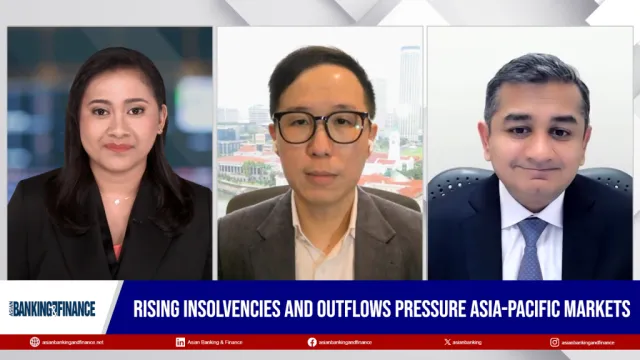Plotting a Roadmap to a thriving Digital Finance Ecosystem
By Daniel Wu & Pat PatelWith the growth of DFS as a key element of the everyday lives of more users here and across the region, it is vital that the infrastructure supporting these technologies remains robust and resilient while providing strong foundations for innovation, writes AWS' Daniel Wu and Elevandi's Pat Patel.
This past November marked the 8th anniversary of the Singapore Fintech Festival (SFF), which has grown more than sixfold since its first year to host 62,000 participants from over 115 countries this year. SFF’s explosive growth reflects not only the breakneck pace of growth in the fintech space, but also the deeper integration of digital financial services (DFS) into the everyday lives of many more regular users.
Recent disruptions in DFS systems in Singapore have been brief, but impactful—demonstrating the vital role such systems now play in the daily lives of Singaporeans. With the growth of DFS as a key element of the everyday lives of more users here and across the region, it is vital that the infrastructure supporting these technologies remains robust and resilient while providing strong foundations for innovation.
In light of this, three pillars will become increasingly important to the growth of DFS across the Asia-Pacific (APAC) region: Resilient Architecture, Enabling Policy, and Novel Industry Collaborations. These pillars will drive the development and adoption of cutting-edge technologies, fostering evolution while ensuring that new technologies can be rolled out reliably to meet the needs of new users.
Catalyzing Resilience for Innovation
One mechanism for making DFS more resilient is through robust Know Your Customer (KYC) systems. KYC systems within the financial services sector help institutions remain vigilant to fraud, corruption, and money laundering activities, improving reliability and safeguarding the funds and data of users.
With the rise of digital financial services (DFS)-enabled mechanisms like peer-to-peer transactions such as Singapore’s PayNow, strong KYC systems instill confidence in the integrity of financial transactions, and promote the adoption of more varied financial products.
Currently, financial institutions bear responsibility for KYC verification processes for each new customer. This means users must repeatedly undergo time-consuming identity verification procedures for different financial service providers. While these procedures are vital, they can inadvertently pose hurdles to user engagement.
Increasingly, though, new technologies like artificial intelligence and machine learning can generate more comprehensive customer profiles, reducing user friction while improving accuracy and efficiency.
Governments are taking notice of these trends. Today, national ID systems using these new technologies greatly strengthen KYC processes across the board and streamline access to DFS. A national ID system provides individuals with unique, government-verified digital identities that can be used to access a wide array of services, including financial ones.
An example of a National ID system is Singapore’s Singpass program. Developed and deployed as part of Singapore’s National Digital Identity framework, Singpass operates as a service layer application that is usable across different government agencies, allowing software applications across agencies to share a central digital identity gateway, thus reducing costs and complexity for users.
Due to the integration of Singpass into the DFS ecosystem, more Singaporeans than ever before have easy and secure access to many financial products and digital services. To date, Singpass is used by 4.5 million users in the city-state—or almost 97% of the eligible population—executing 350 million transactions a year to access more than 2,000 public and private sector services.
Similar systems across the region, including India’s Aadhaar program are even more directly integrated into the DFS ecosystems of their countries—with Aadhaar being used by the Indian government to help its massive unbanked population rapidly gain access to financial services.
Enabling policies drive technological shifts
As DFS adoption grows and systems evolve, enabling policies will become ever more important. Such policies should strike a balance in allowing financial services to embrace technologies they need to grow, while still providing clear guidelines on implementing necessary safeguards.
For example, governments may seek to guide the use of cloud services within the financial sector by developing cloud implementation guidelines or outsourcing guidelines. Such guidelines would establish safeguards and procedures to help the financial sector adopt cloud technologies successfully.
An example of such a guideline is the “Cloud Implementation Guide 2.0 for the Financial Industry in Singapore”, developed by the Association of Banks in Singapore (ABS), which provides a framework for cloud service provider assessment and provides guidance on entering a cloud outsourcing arrangement.
By providing clear directions for banks and cloud service providers to follow, such guidelines empower more banks to innovate using cloud computing, to boost the security and reliability of their DFS systems, while creating better, more tailored, and more reliable financial products for users.
This has been what has allowed TNEX, Vietnam’s first digital-native bank, to pursue a cloud-default approach to designing their banking services, allowing them to enrol 250,000 retail customers and 20,000 SMEs in their first year, after a setup period of only nine months.
TNEX’s example also illustrates the importance of regulations which foster innovation and competition in the DFS and fintech sectors to allow new players to enter markets and thrive through their use of technology, or by collaborating with existing financial institutions to enhance their capabilities.
Designing novel industry collaboration mechanisms
As the DFS landscape changes, governments and businesses must jointly determine the future of the sector through public-private collaboration on policymaking.
For example, regulatory sandboxes create safe spaces for innovation and technological experimentation for businesses, while policymakers gain insights, challenges, and opportunities that accompany these innovations. Sandboxes are thus an opportunity for regulators to work with industry to craft policy that balances innovation with safety.
Vitally, dialogue must remain at the heart of collaboration between industry and government if we are to ensure that the sector remains vibrant and dynamic. This is the aim of platforms like the annual Point Zero Forum held in Zurich this past June, which unites central banks, regulators, policymakers, and industry leaders from around the world in conversations about financial technologies.
For the Asia-Pacific region, however, the SFF is the premier destination for industry to meet policymakers, to share perspectives, and set in motion plans that will shape the future of DFS and the financial sector. This year, SFF provided a glimpse into the exciting new technologies, fintech trends, and regulatory innovations which will pave the way forward. We remain confident it will continue to do so in 2024, and many years after that as well.

















 Advertise
Advertise










